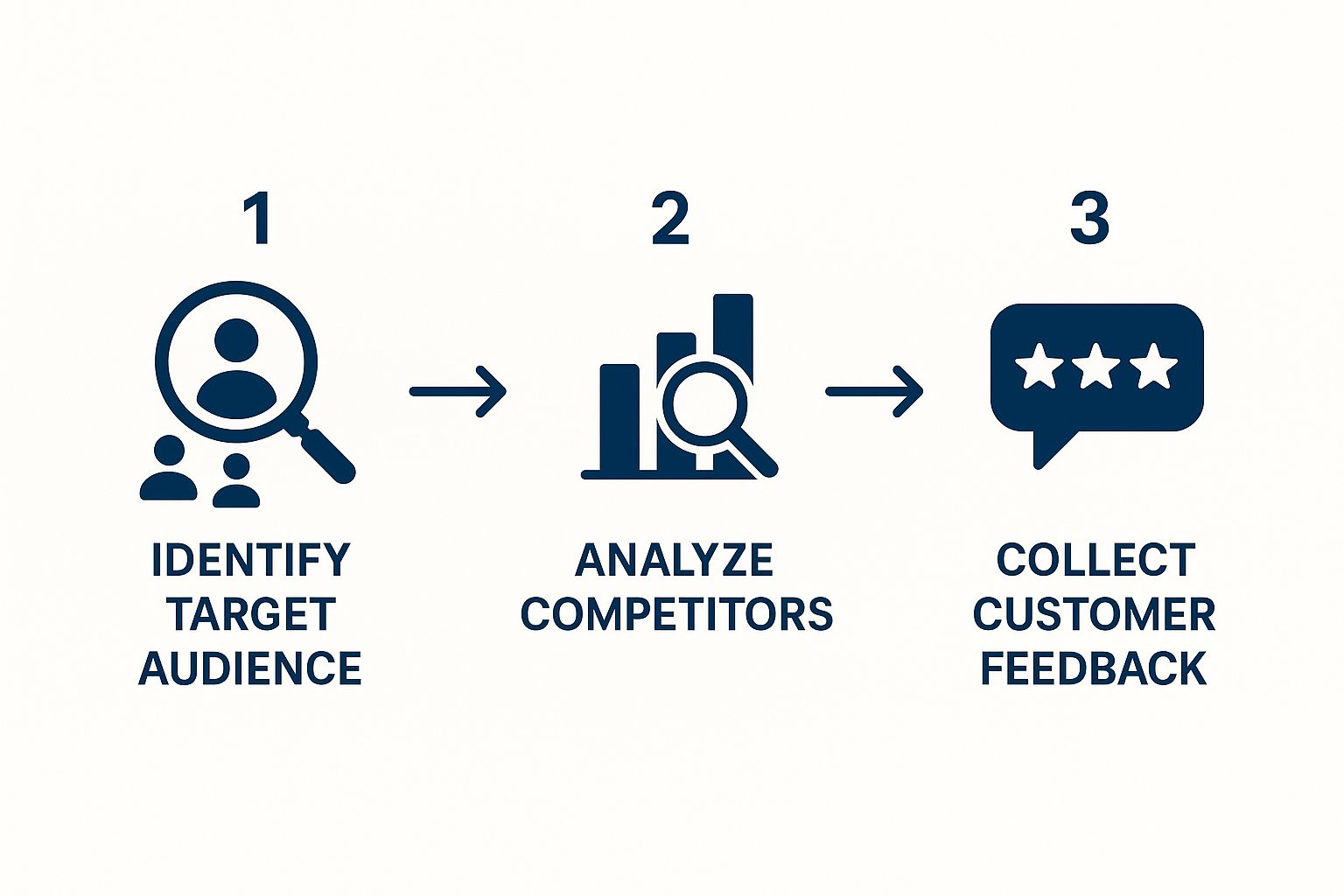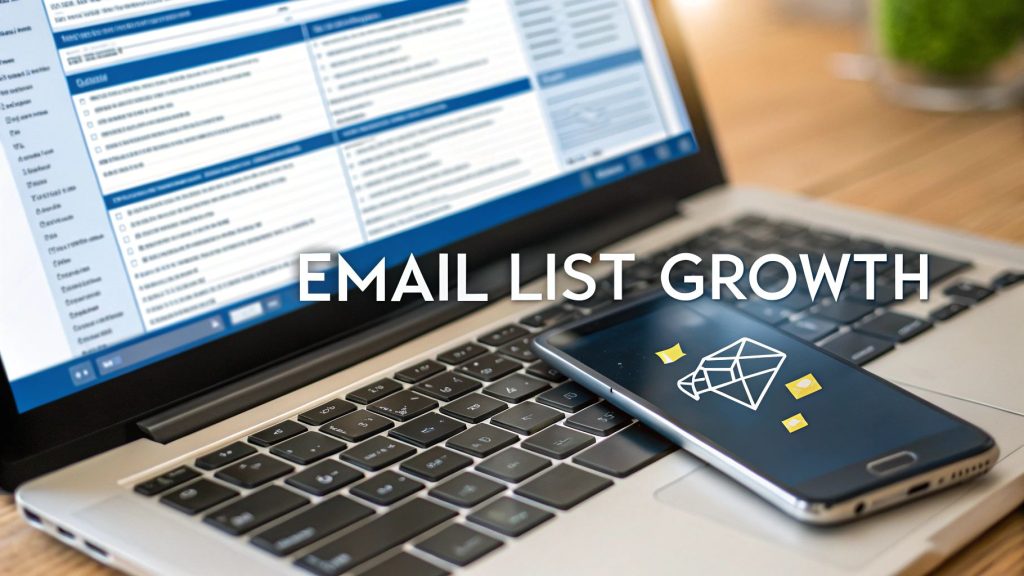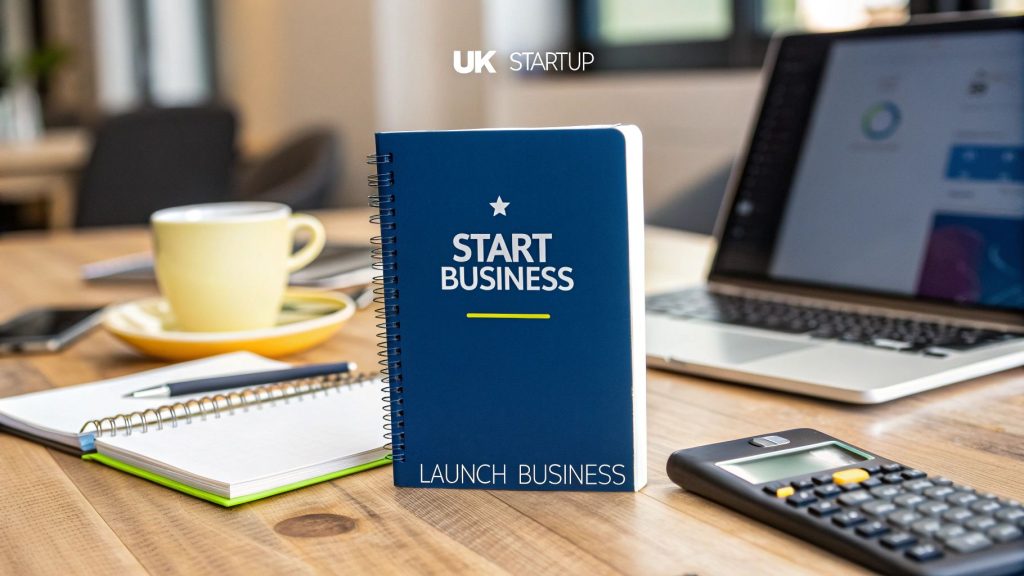How to Grow a Business The Right Way
Before you can figure out how to grow a business, you need a foundation that’s stable and reliable. Growth is all about intelligent scaling—not just getting bigger for the sake of it. The real secret is making sure your current operations, finances, and customer base are strong enough to handle expansion without everything collapsing under the pressure.
Building a Rock-Solid Foundation for Growth
Every ambitious entrepreneur dreams of expansion, but chasing growth too soon can be a recipe for disaster. It’s one of the most common reasons promising start-ups fail. Think of it like trying to build a skyscraper on foundations meant for a bungalow—it simply can’t hold the weight.
Before you even think about hiring more staff or opening a new location, you have to be brutally honest with yourself: is the business truly ‘growth-ready’?
This isn’t about abstract theory; it’s about stress-testing your current model. Can your processes handle double the orders tomorrow? Is your cash flow predictable enough to survive a rough patch? For instance, if you run an e-commerce store that ships 50 orders a day, what would happen if a marketing campaign went viral and you suddenly had 500 orders? Do you have enough packing materials, staff hours, and shipping labels ready to go? Answering these questions now will save you from making very expensive mistakes later on.
Pinpoint Your Most Valuable Customers
Growth has to be strategic, not scattered. A critical first step is figuring out who your most profitable customers really are. Who are the clients that not only spend the most but also refer others and need the least amount of hand-holding? Don’t just guess—dig into your data.
A local bakery, for example, might assume its weekend foot traffic from families is its lifeblood. But after looking at the numbers, they could discover their most profitable orders actually come from corporate catering during the week. By focusing their growth efforts there—maybe by launching a new lunch delivery service for offices—they can expand far more efficiently than just trying to get more random people through the door.
This visual breaks down the core process for understanding your market position before you pull the trigger on scaling.

As you can see, real growth starts with deep customer knowledge. That insight then shapes how you position yourself against competitors and, ultimately, how you improve what you offer.
Shore Up Your Internal Processes
Your internal operations are the engine of your business. If they’re clunky and inefficient now, scaling will only pour fuel on the fire. It’s time to map out your key workflows, from the first customer email right through to final delivery. Where are the bottlenecks? What tasks are eating up the most time for the least reward?
A practical example is a small web design agency. If the founder is the only person who can send a final invoice, that becomes a bottleneck. When they go on holiday, payments grind to a halt. The solution is to create a documented invoicing process and use accounting software that another team member can access, ensuring the business gets paid on time, every time.
A business ready for growth has systems that can run without constant founder intervention. If every small decision still requires your approval, you’re not ready to scale—you’re just creating a bigger job for yourself.
In the UK, small and medium-sized enterprises (SMEs) are the lifeblood of the economy. As of early 2024, there were around 5.5 million private sector businesses, and SMEs accounted for a staggering 99.9% of them. These businesses are vital, employing nearly 60% of the private sector workforce, which shows just how much potential they have when they grow correctly.
You can find more fascinating UK business statistics on money.co.uk. This context matters. Knowing the market you’re in is the first real step toward building a resilient company that’s truly built to last.
To help you get a clear picture of where you stand, use this self-assessment checklist. It’s a simple way to gauge whether you’re genuinely ready for the next big step or if there are a few cracks in the foundation that need filling first.
Your Growth Readiness Checklist
| Growth Area | Key Question to Ask | Signs of Readiness | Red Flags to Address |
|---|---|---|---|
| Operations | Can our current systems handle a 2× increase in orders without breaking? | Processes are documented, automated where possible, and not reliant on one person. | Constant firefighting, frequent errors, key tasks are still manual and time-consuming. |
| Finance | Is our cash flow consistently positive and predictable? | You have at least 3–6 months of operating expenses in reserve and clear financial reporting. | Relying on last-minute sales to make payroll; unsure of your exact profit margins. |
| Customers | Do we have a loyal, repeatable customer base? | High customer retention rate; consistent positive feedback and referrals. | High customer churn; most new business comes from one-off, discounted sales. |
| Leadership | Can the business run smoothly for a week without me? | You have a trusted team or key employees who can make decisions independently. | You are the bottleneck; every approval and decision has to go through you. |
Mastering Your Finances for Smart Expansion
Growth always costs money, but smart financial management is the engine that actually drives it. If you want to figure out how to grow a business sustainably, you need to stop thinking just about profits and start acting like a strategic investor. This isn’t about becoming an accountant overnight; it’s about getting clarity and foresight over your numbers.
Expansion puts intense, and often surprising, pressure on your cash flow. Suddenly, you’ve got a higher payroll, bigger supplier invoices, and new marketing costs to cover. All of these need paying before the revenue from that growth starts rolling in. Without a clear financial roadmap, even a wildly successful expansion can trigger a cash crisis.

Creating Forecasts That Inspire Confidence
A solid financial forecast is your most powerful tool. It’s not a wild guess about the future; it’s a story told with numbers, proving to potential investors or lenders that you truly understand the mechanics of your business. It shows you’ve thought through the best-case, worst-case, and most-likely scenarios.
Imagine a local catering business that wants to open a second location. They don’t just walk into the bank and say, “we’re popular.” Instead, they present a detailed cash flow projection showing:
- Increased Costs: Rent for the new premises (£2,000/month), staff wages for two new employees (£4,000/month), and marketing launch expenses (£1,500).
- Projected Revenue: Based on conservative estimates from their existing location’s data, projecting £8,000 in month one, growing to £12,000 by month three.
- Break-Even Point: The exact month they anticipate the new location will start paying for itself (e.g., month four).
That level of detail turns a risky idea into a calculated investment. To get started, you can use our free cashflow forecast template to map out your own financial future. It’s a simple tool that helps you anticipate shortfalls and plan for investments with far greater confidence.
Navigating Your Funding Options
Once your forecasts are solid, the next job is to secure the capital. The right path depends entirely on your business stage, industry, and growth ambitions. There’s no one-size-fits-all answer here.
The goal isn’t just to get money; it’s to get the right money. Choosing the wrong funding partner or taking on inappropriate debt can cripple your business just as effectively as having no funding at all.
For many, bootstrapping—reinvesting profits back into the business—is the ideal route. It means you keep full ownership and control, but it can also mean slower growth.
Alternatively, you could seek external funding. Here’s a quick breakdown of common options in the UK:
- Angel Investors: High-net-worth individuals who invest their own money in early-stage companies in exchange for equity. They often bring valuable mentorship alongside their capital. For example, the founders of Deliveroo received early-stage funding from angel investors who had experience in logistics and tech.
- Venture Capital (VC): Firms that invest larger sums in businesses with high-growth potential, also for equity. This route is best for companies aiming for rapid, large-scale expansion, like a tech startup preparing to enter a new international market.
- Bank Loans: Traditional debt financing. It’s a good option if you have a strong trading history and tangible assets, but you must be confident you can meet the repayment schedule. A construction company might use a bank loan to buy a new excavator to take on larger contracts.
- UK Government Grants: Schemes like those from Innovate UK offer non-repayable funding for businesses working on specific innovative projects. They are highly competitive but don’t require you to give up any equity.
A tech startup seeking VC funding would prepare a compelling “financial story.” This would include not just projections but also key metrics like Customer Acquisition Cost (CAC) and Lifetime Value (LTV) to prove their business model is scalable and profitable.
Making Strategic Investments in Technology
Knowing where to put your capital is just as important as getting it. The key is to invest in assets that drive genuine productivity and create a competitive advantage, especially when it comes to technology.
For example, a growing e-commerce store might invest in an automated inventory management system. This might seem like a hefty upfront cost, but it eliminates costly human errors, prevents stockouts, and frees up staff time for higher-value tasks like customer service. That’s a strategic investment that pays for itself many times over. The focus should always be on tools and equipment that directly boost your capacity to serve more customers more efficiently.
Building a Team That Can Drive Growth
Sooner or later, every founder hits a wall. It’s the moment you realise you simply cannot do it all yourself. This is the simple, unavoidable truth of scaling a business.
The journey from a solo operator to a genuine leader is often the toughest part of growing. It’s not just about getting more sales; it’s about building an organisation that can handle that success without you being the bottleneck. This is where so many promising businesses stumble—they forget the human side of growth.
A team that can power your expansion doesn’t just appear out of nowhere. You have to build it intentionally, starting with the recognition that the skills that got you here won’t get you there. Your first hires are, without a doubt, your most important.
Transitioning from Founder to Leader
As the founder, you’ve probably worn every hat in the company: sales, marketing, finance, customer service, you name it. But growth demands a change. You have to stop doing all the work and start leading the people who do the work. This means letting go, which is often easier said than done.
Learning to delegate effectively is the first hurdle. And I don’t just mean offloading the tasks you hate. Proper delegation is about empowering others to take real ownership.
A great way to start is by documenting your key processes. Create simple, clear guides for the most common tasks in your business. This does two things: it ensures consistency and gives your new team members the confidence to act without needing your approval for every little thing.
Another practical tip? Hire for your weaknesses. If you’re a creative visionary who dreads looking at spreadsheets, your first key hire shouldn’t be another ideas person. It should be someone who genuinely enjoys numbers and can bring financial rigour to your operations. For more on this, our ultimate guide to hiring your first employee offers a solid framework to help you nail this critical decision.
Cultivating a Culture of Ownership
A strong company culture is your secret weapon during periods of rapid change. It’s the invisible force that guides your team’s decisions when you’re not in the room. A culture built for growth is one that encourages smart experiments, accepts that the odd failure is just a learning opportunity, and celebrates wins as a team.
This doesn’t happen by accident. You have to actively shape it.
- Communicate the Vision: Your team needs to know why the business is growing. Share your long-term goals and be crystal clear about how each person’s role helps achieve that bigger mission. For instance, “Our goal is to be the #1 rated independent coffee shop in Manchester by 2026, and your role as barista is key because you create the amazing experience that gets us those 5-star reviews.”
- Implement Simple Training: You don’t need a huge corporate training department. A simple weekly ‘lunch and learn’ or pairing a new starter with a more experienced team member can be incredibly effective.
- Encourage Autonomy: Give your team the authority to make decisions within their roles. This not only builds their confidence but also frees you up to focus on strategy. For example, empower your customer service lead to issue a refund up to £50 without needing your approval.
Your real goal is to build an organisation that can run—and even thrive—without you being involved in every single detail. This isn’t a sign that you’re becoming obsolete; it’s the ultimate proof of successful leadership.
A Practical Example of Team Scaling
Let’s look at a small digital agency I know. They grew from three founders to a team of 15 in just one year. The founders quickly realised they were the main bottleneck. They were still trying to approve every social media post and sit in on every client call, which was completely unsustainable.
To get ahead of the chaos, they hired their first two senior managers: a Head of Operations and a Head of Client Strategy.
To keep everyone on the same page, they put a simple communication structure in place:
| Communication Method | Frequency | Purpose |
|---|---|---|
| All-Hands Meeting | Weekly | Share major wins, company-wide updates, and reinforce the mission. |
| Team Huddles | Daily | Quick 15-minute stand-ups for teams to align on daily priorities. |
| One-to-One Meetings | Bi-weekly | Managers meet with direct reports to discuss performance, challenges, and growth. |
This simple framework brought clarity and predictability during a hectic period of growth. Information flowed freely, preventing silos from forming before they had a chance. The founders could finally step back from the day-to-day grind, confident that the right people and processes were in place to steer the ship.
This is how you build a team that doesn’t just survive growth, but actively drives it.
Finding New Customers Through Smart Marketing
Once you’ve built a solid foundation, got your finances in order, and know your team is ready, the next step is to ramp up your marketing. A healthy business needs a constant flow of new customers to grow, and that doesn’t happen by accident. This isn’t just about posting a bit more on social media; it’s about building a smart, scalable engine that consistently brings in new business.
Real growth marketing is about using data and clever strategies to find and win over new customers, whether they’re in the next town over or a different country entirely. The aim is to create targeted campaigns that deliver a clear, measurable return on your investment.

Use Data to Understand Your Customers
Before you even think about spending money on ads, you need to know who you’re talking to. Thankfully, modern digital tools give us incredible insight into customer behaviour. Tools like Google Analytics can show you exactly how people find your website, which pages they love, where they come from, and what they do right before they buy.
This data is gold. For example, imagine you run an online store selling eco-friendly pet supplies in the UK. By looking at your analytics, you notice a surprising amount of website traffic coming from Bristol, a city where you do zero advertising. That’s a massive clue pointing to an untapped market. You can then create Facebook ad campaigns aimed directly at pet owners in Bristol, making every pound you spend work much harder.
Find Marketing Channels That Can Grow With You
Not all marketing channels are built for growth. Some are brilliant for landing your first handful of customers, while others are designed to reach thousands. The trick is to find the right mix for where your business is right now.
Growth isn’t about being everywhere at once. It’s about being in the right places, consistently, with a message that connects. Focus on mastering one or two scalable channels before trying to conquer them all.
Budget is a big deal for most startups, but the good news is you don’t need a massive investment to get started. There are plenty of effective, scalable options out there. We’ve put together a great starting point in our guide on 10 proven low-cost marketing strategies for startups.
Case Study: A UK Distillery’s European Expansion
Let’s look at a real-world example. A small, UK-based craft gin distillery had built a loyal local following through word-of-mouth and regional events. To really grow, they knew they needed to think bigger than their home county.
Instead of launching a broad, expensive national campaign, they let the data lead the way.
- Find the Audience: They used social media analytics and spotted that gin lovers in Germany and the Netherlands were already sharing and talking about their products.
- Targeted Ads: They ran highly specific ad campaigns on Facebook and Instagram, aimed at users in those countries who had shown an interest in craft spirits.
- Easy Buying Process: They made sure their e-commerce platform was seamless, with crystal-clear international shipping options. No friction, no lost sales.
The results were incredible. Within a year, over 30% of their online sales were coming from mainland Europe. They took a local favourite and turned it into an international brand, all by making smart, data-led marketing decisions. It’s a perfect example of how to grow a business beyond your borders.
This digital-first approach is becoming the norm. The total number of UK businesses has shot up by 59% since 2000, largely thanks to easier access to digital tools. Just look at UK e-commerce, which generated around £2.2 billion in revenue in January 2025 alone. You can find more insights on UK small business trends over on airwallex.com.
Case Study: A UK Distillery’s European Expansion
Let’s look at a real-world example. A small, UK-based craft gin distillery had built a loyal local following through word-of-mouth and regional events. To really grow, they knew they needed to think bigger than their home county.
Instead of launching a broad, expensive national campaign, they let the data lead the way.
- Find the Audience: They used social media analytics and spotted that gin lovers in Germany and the Netherlands were already sharing and talking about their products.
- Targeted Ads: They ran highly specific ad campaigns on Facebook and Instagram, aimed at users in those countries who had shown an interest in craft spirits.
- Easy Buying Process: They made sure their e-commerce platform was seamless, with crystal-clear international shipping options. No friction, no lost sales.
The results were incredible. Within a year, over 30% of their online sales were coming from mainland Europe. They took a local favourite and turned it into an international brand, all by making smart, data-led marketing decisions. It’s a perfect example of how to grow a business beyond your borders.
This digital-first approach is becoming the norm. The total number of UK businesses has shot up by 59% since 2000, largely thanks to easier access to digital tools. Just look at UK e-commerce, which generated around £2.2 billion in revenue in January 2025 alone. You can find more insights on UK small business trends over on airwallex.com.
Comparing Scalable Marketing Channels
Choosing where to put your marketing budget can feel overwhelming. To help you weigh up your options, here’s a quick comparison of some of the most effective and scalable channels for a growing business.
Ultimately, the best approach is to test, measure, and adapt. Start with the channel that feels like the best fit for your audience and budget, track your results like a hawk, and then double down on what’s working. This cycle of testing and refining is the surest way to find new customers and build sustainable growth.
| Marketing Channel | Initial Cost | Scalability Potential | Best For Which Business Type |
|---|---|---|---|
| Search Engine Optimisation (SEO) | Low (time-intensive) | Very High | Service businesses, e-commerce, content-led brands aiming for long-term organic traffic. |
| Pay-Per-Click (PPC) Advertising | Medium to High | Very High | Businesses with a proven sales funnel and a clear customer lifetime value. Offers immediate results. |
| Content Marketing | Low to Medium | High | B2B companies, niche consumer brands, and businesses with a longer sales cycle. Builds authority and trust. |
| Email Marketing | Low | High | Nearly all business types. Excellent for nurturing leads and increasing customer retention and repeat purchases. |
Ultimately, the best approach is to test, measure, and adapt. Start with the channel that feels like the best fit for your audience and budget, track your results like a hawk, and then double down on what’s working. This cycle of testing and refining is the surest way to find new customers and build sustainable growth.
Optimising Operations to Handle More Business
Growth has a nasty habit of exposing every single crack in your operational foundations. A process that works perfectly well for a team of five will quickly start to buckle and break under the strain of twenty. When figuring out how to grow a business, it’s easy to get fixated on sales and marketing, but optimising your internal engine is just as critical.
Without solid operations, you risk disappointing those hard-won new customers with slow service, costly mistakes, and a generally chaotic experience. This isn’t about splashing out on expensive overhauls; it’s about building slick, repeatable systems that can handle more demand without you constantly having to fight fires. It’s about making sure your product or service quality stays high, no matter how many orders are flying through the door.

Map Your Workflows to Find the Bottlenecks
You can’t fix what you can’t see. The first thing you need to do is visually map out your core business processes from start to finish. Take a key workflow, like “from new customer enquiry to project completion,” and document every single step involved.
Who takes the initial call? Where does that information go next? How is the project assigned, tracked, and finally delivered? You have to be brutally honest and incredibly detailed here.
Once you’ve got it all laid out, the bottlenecks will become glaringly obvious. Maybe every single invoice has to be manually approved by you, creating a constant delay. Or perhaps your customer service team wastes hours hunting through multiple systems just to find one piece of client information. These are the friction points that will bring your growth to a grinding halt.
Your goal is to create a system where work flows smoothly, not one that constantly needs a manager to unclog a blockage. A bottleneck isn’t just an inconvenience; it’s a direct cap on your business’s potential growth.
Use Technology to Automate Repetitive Tasks
Once you’ve pinpointed the manual, time-sucking tasks, it’s time to bring in affordable tech to automate them. Automation isn’t about replacing people; it’s about freeing them from low-value work so they can focus on what really matters—serving customers and improving your product.
Plenty of off-the-shelf software solutions are designed specifically for small businesses and can be rolled out without a huge budget or a team of IT experts.
- Customer Relationship Management (CRM): A simple CRM like HubSpot or Zoho can centralise all your customer data, track interactions, and automate follow-up emails, saving your sales team countless hours.
- Project Management Tools: Platforms like Asana, Trello, or Monday.com give everyone visibility over who is doing what and when. This stops tasks from falling through the cracks when things get busy.
- Accounting Software: Tools such as Xero or QuickBooks automate invoicing, track expenses, and give you a real-time view of your financial health, which is absolutely essential during a growth phase.
- Inventory Management: For product-based businesses, software can automatically track stock levels, reorder popular items, and integrate directly with your shipping providers.
Practical Example: A Subscription Box Success
Let’s look at a small UK-based subscription box company that started in the founder’s living room. In the beginning, managing 50 subscribers was a piece of cake. The founder manually updated a spreadsheet, printed shipping labels one by one, and packed each box herself.
But when orders surged to 500 a month, this manual system completely collapsed. She was spending entire days on admin instead of sourcing great products for her boxes. Shipping errors shot up, and customers were getting frustrated.
Her solution was to invest in an affordable e-commerce and inventory management platform. Here’s what it changed overnight:
- Automated Order Processing: When a customer signed up, the system automatically created an order, updated her inventory levels, and added the customer to her email marketing list.
- Streamlined Shipping: The software integrated with Royal Mail, letting her print hundreds of shipping labels in a single batch, complete with tracking information.
- Data-Driven Decisions: She could now instantly see which products were most popular, helping her make smarter buying decisions for future boxes.
By putting this system in place, she saved an estimated 20 hours a week on manual tasks and cut her shipping errors by over 90%. This operational efficiency was the key that unlocked her ability to scale to thousands of subscribers without descending into chaos. She built a system that was flexible enough to grow with her business.
Common Questions About Growing a Business
Scaling a business is exciting, but it’s a path filled with questions. Every founder I’ve ever spoken to has wondered if they’re making the right moves at the right time. Let’s tackle some of the most common queries I hear, with some straight-talking, practical advice to help you navigate your own growth journey.
When Is the Right Time to Grow My Business?
The urge to scale often hits when sales are on an upward trend, but that’s not the whole story. The real green light for growth is when your business has a stable, predictable foundation.
Look for key indicators. Are you consistently profitable? Is revenue reliable, or is it a rollercoaster? You also need happy customers who stick around – that’s your proof that the core of your business is strong.
But here’s the most critical test: can the business run smoothly without you personally firefighting every single day? If you’re completely snowed under with the current workload or your cash flow is all over the place, hit the brakes. Pushing for growth now will only pour fuel on an existing fire. A practical example: a solo graphic designer with a 3-month waiting list might think it’s time to hire. But if they haven’t documented their design process or client onboarding, bringing someone new in will create more chaos, not less. The right time to grow is after they’ve systemised their work, not before.
What Is the Biggest Mistake to Avoid When Expanding?
Without a doubt, the most damaging mistake is growing too fast. Founders get caught up in the excitement and expand without the cash or systems to back it up. This almost always leads to a cash flow crisis. You’re suddenly paying for new staff, bigger premises, or more stock before the revenue from all those new customers has even hit your bank account.
The other classic error is letting quality slide in the race for quantity. When you’re scrambling to handle more volume, it’s tempting to cut corners on customer service. Don’t do it. You risk destroying your brand’s reputation and alienating the loyal customers who got you here in the first place.
Always choose sustainable, controlled growth over a frantic, risky dash for the top. A slower, steadier climb is far better than a quick spike followed by a sudden collapse.
How Can I Grow Without Taking on Debt?
Growing without debt – often called bootstrapping – is entirely possible, but it takes serious financial discipline. The whole idea is to be strategic, funnelling your profits straight back into the business to pay for your expansion.
This forces you to focus on lean, high-return tactics. Forget expensive gambles; you need things that work. Some of the most effective strategies include:
- Content Marketing & SEO: It’s a long game, but building organic traffic is one of the most powerful, low-cost ways to attract a steady stream of new customers.
- Obsess Over Customer Retention: It’s far cheaper to keep the customers you have than to find new ones. Focus on increasing their lifetime value.
- Find Operational Efficiencies: Automate boring admin tasks or streamline your workflows. Every bit of cash you save on overheads is money you can reinvest in growth.
- Launch High-Margin Offers: Think about what else you could sell to your existing, happy customers. A new, profitable product or service can boost revenue without a massive marketing budget.
For instance, a marketing agency I know created a high-value digital course for its existing clients. It generated a fantastic new revenue stream with minimal upfront cost, giving them the capital to hire a new team member and upgrade their software.
Should I Get New Customers or Sell More to Existing Ones?
It’s a balancing act, but you should never, ever take your eye off your existing customers. The data doesn’t lie: it’s 5 to 25 times more expensive to acquire a brand-new customer than it is to keep a current one. Your loyal fans are your most valuable asset, period.
Start by making sure you’re getting the most value from the customers you already have. You can do this by:
- Upselling: Offering them a premium, upgraded version of something they already love. For example, a software company could offer a “Pro” version with more features to its base of free users.
- Cross-selling: Suggesting complementary products that make their original purchase even better. A phone retailer might offer a protective case and screen protector at the checkout.
- Loyalty Programmes: Rewarding repeat business gives them a great reason to stick with you. A coffee shop’s “buy nine, get the tenth free” stamp card is a classic, effective example.
Once you have a rock-solid retention strategy in place, you can invest in new customer acquisition with much more confidence. You’ll know that you have a profitable, stable foundation ready to welcome all that new business.
At Grow My Acorn, we believe smart, sustainable growth is built on a foundation of knowledge and strategy. Explore our extensive resources to get the practical advice you need to take your business to the next level. Find out more at https://growmyacorn.co.uk.














































